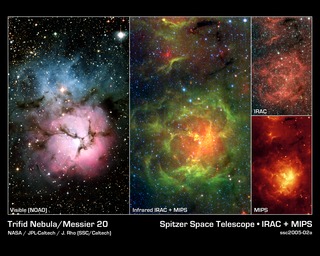
News Release • April 28th, 2006 • feature06-12 •
Written by Linda Vu
Spitzer Science Center
Self-help books and grade school teachers have been promoting this tip for decades: To keep success in sight, make a list of goals.
Before launch, astronomers and engineers working on NASA's Spitzer Space Telescope applied this tip to astronomy when they developed a list of basic goals for the mission to accomplish. The list was referred to as Level 1 Mission Requirements, and Spitzer's "mission success" was to be measured on the telescope's ability to effectively accomplish every requirement.
On April 27, 2006, Spitzer officially satisfied the last open goal on the Level 1 Mission Requirement list, which required the telescope to obtain spectacular infrared images of the cosmos for at least two and a half years.
"The Spitzer Space Telescope continues to shine as a crowning jewel in NASA's Great Observatory program. We now enjoy the satisfaction of having successfully completed all of the Level 1 Requirements. Our focus is lifted beyond the horizon in wonderment as to what additional new science will be realized as we move beyond the requirement to the completion of the mission," says Spitzer project manager, Robert Wilson.
Later this month, on May 29, 2006, Spitzer will celebrate another milestone, it's 1000th day in space. Thanks to an innovative group of engineers and astronomers, expectations are high that the telescope will continue to uniquely probe the infrared universe beyond its ultimate pre-launch goal of five years.





